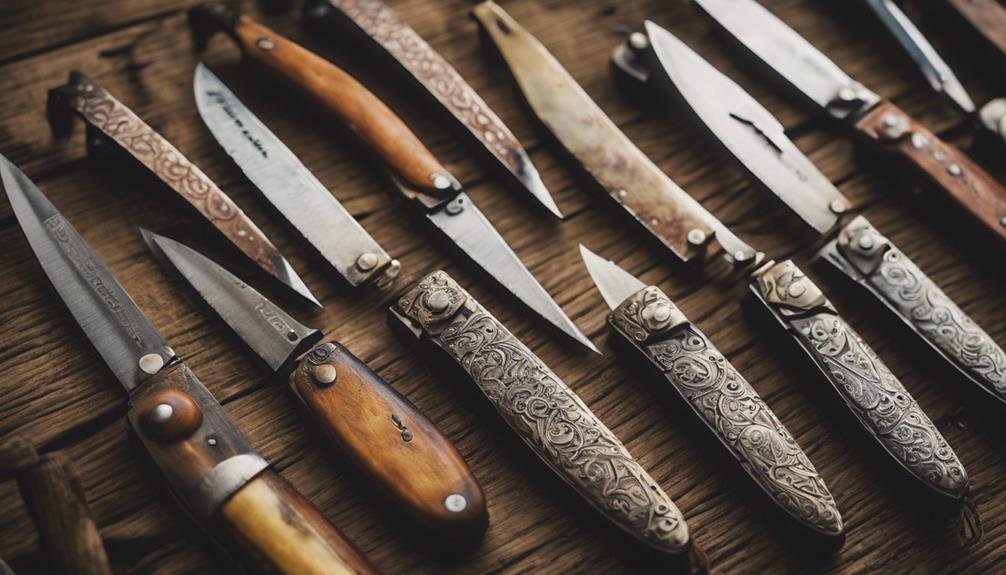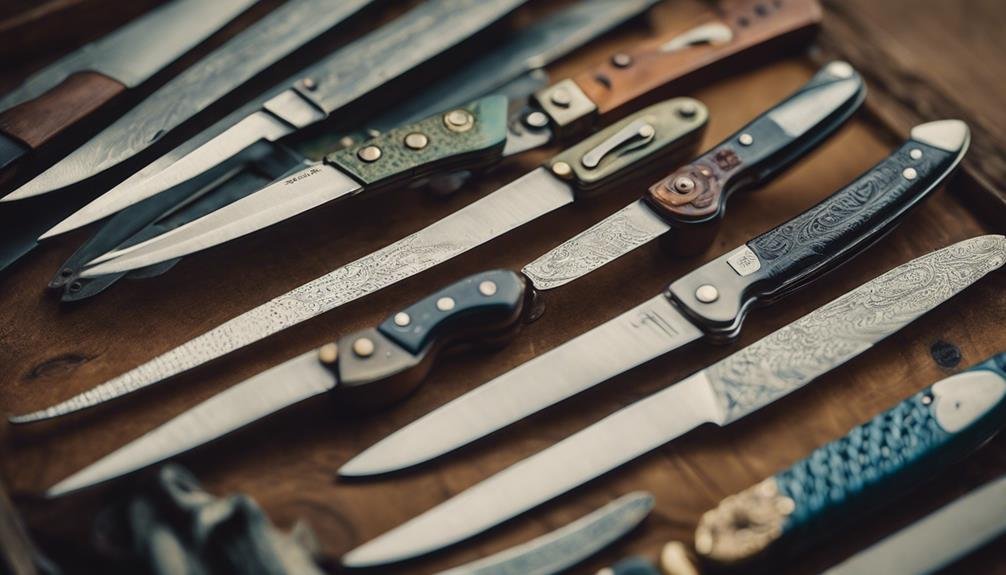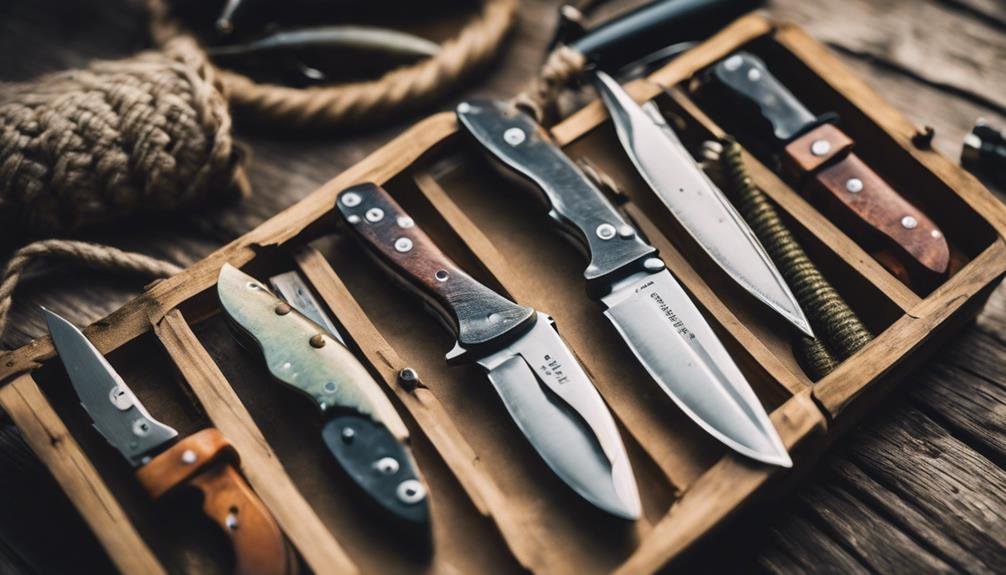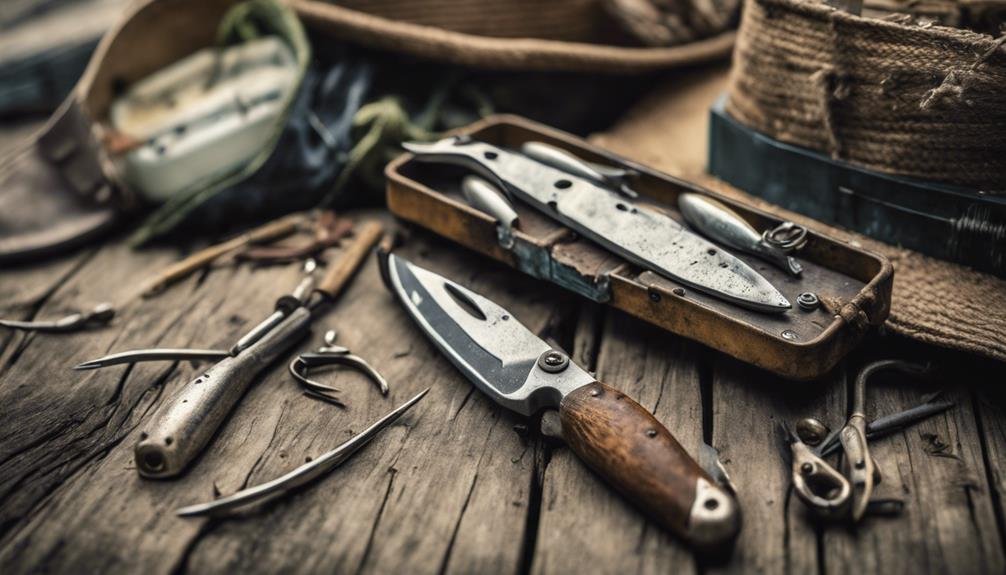If you have ever stumbled upon a vintage folding fishing knife, you might wonder about the stories it holds and the hands that once wielded it. These relics of the past, with their intricate designs and sturdy blades, evoke a sense of nostalgia and curiosity. But what sets these knives apart? Why do collectors seek them out with such enthusiasm? Let’s explore the allure of vintage folding fishing knives, their history, and the secrets they carry from generations past.
Key Takeaways
- It emerged in the 1960s or 1970s for fishing enthusiasts.
- Made with plastic or celluloid scales, it features a dual-blade design.
- Collectible for historical significance, ergonomic designs, and durability.
- Care involves cleaning with mild soap, drying, lubricating, and inspecting regularly.
- Available on specialized knife collector websites with varying prices based on brand, rarity, and condition.
History of Vintage Fish Knives

Vintage fish knives emerged in the 1960s or 1970s, commonly spotted in pawn shops or flea markets. These folding knives were often part of a set designed for fishing enthusiasts. Made with plastic or celluloid scales, vintage fish knives are recognized for their dual-blade feature, comprising a main blade for cutting and a scaler for scraping off fish scales.
Despite their tendency to tarnish and pit due to aging, these knives remain popular among anglers for their ergonomic design and practicality in cleaning and preparing fish. Anglers appreciate these vintage fish knives’ functionality, making them a staple tool for any fishing trip.
The history of vintage fish knives showcases how these tools have stood the test of time, becoming cherished items among those who enjoy the art of fishing. Their durability and utility have solidified their place in the hearts of anglers worldwide.
Popular Brands and Models
Lastly, the Vintage Old Hammer Brand Single Blade White Fishing Pocket Knife stands out with its serrated back, making it a unique addition to any fishing tool collection.
Finally, the Vintage Colonial Stockman Pocket Knife is a popular choice among enthusiasts, available for USD 30.00.
Another interesting find is the Vintage Fish Knife Pocket Knife By Imperial Made In Ireland, an old antique advertising pocket knife also priced at USD 30.00.
The Vintage J Marttiini Finland Fillet Knife from the 1960s features an island ground stainless fish fillet knife with a signed wood handle, priced at USD 36.68.
The Vintage Colonial Pocket Fish Knife is a classic collectible priced at USD 38.00. It is popular among collectors and enthusiasts for its unique designs and functionality.
Collecting Vintage Fish Knives

When starting your collection of vintage fish knives, consider exploring the historical significance, ergonomic designs, and durability that make these items highly sought after by enthusiasts.
Vintage fish knives, dating back to the 1960s or 1970s, can often be discovered in pawn shops or flea markets. These collectible knives typically come in sets and feature plastic scales or celluloid that may tarnish and pit over time.
A classic vintage fish knife usually comprises two blades: a primary blade and a scaler, adorned with an Imperial emblem and a crown. The scaler on these knives is specifically designed for scraping scales and often includes additional tools like a cap lifter and hook tool.
Despite their age, vintage fish knives are valued for their historical significance, comfortable handle design, and enduring quality. If you want to start your collection, explore the world of vintage fish knives and enjoy the unique features and craftsmanship these pieces offer.
Care and Maintenance Tips
Regularly cleaning the blades and handles of your vintage folding fishing knives with a mild soap and water solution helps to maintain their longevity and performance.
After cleaning, ensure the knives are completely dry before storing them to prevent rust or corrosion on the metal parts.
A thin layer of oil or lubricant is applied to the metal components to maintain smooth operation.
It’s crucial to inspect the folding mechanisms regularly and tighten any loose screws or pivots to guarantee the knives function properly when needed.
When not in use, store your vintage folding fishing knives in a cool, dry place away from direct sunlight. This practice helps preserve the handles and prevents warping or damage over time.
Value and Pricing Guide

To thoroughly understandlding fishing knives, exploring their value and pricing guide is essential. Vintage folding fishing knives can vary in price based on brand, condition, and uniqueness. Some Soviet folding pocket knives from the 1970s can be acquired for as low as $18.05, while rare and distinctive pieces, such as a skull-shaped knife handle, may be priced at $70.00. These vintage fishing pocket knives often include extra tools like scalers and toothpicks, enhancing their functionality for anglers. Enthusiasts highly sought after collectible vintage fishing knives due to their historical significance and unique features. Below is a table summarizing the pricing range for vintage folding fishing knives:
| Price Range | Description |
|---|---|
| $17.55-$69.99 | Range of prices based on brand and condition |
| $18.05 | Soviet folding pocket knives from the 1970s |
| $70.00 | Rare and unique pieces, like a skull-shaped handle |
Where to Buy Vintage Fish Knives
You can easily find vintage fish knives for sale on online marketplaces and specialized knife collector websites. These knives, dating back to the 1960s or 1970s, boast unique designs and materials such as celluloid scales and stainless steel. Collectors are drawn to these vintage fish knives not only for their historical value but also for their exceptional craftsmanship.
Prices can vary depending on age, condition, brand, and rarity, so it’s important to do some research before purchasing.
When browsing for vintage fish knives online, look for reputable sellers who provide detailed descriptions and images to guarantee authenticity. Regular maintenance is vital to preserve these knives and prevent corrosion or damage.
If you’re a collector looking to expand your collection or a fishing enthusiast wanting a piece of history, exploring online platforms is a great way to find these unique pieces that serve a practical purpose and carry a piece of the past.
Conclusion and Final Thoughts

As you consider adding a vintage folding fishing knife to your collection, remember that these timeless pieces hold historical significance and exemplify exceptional craftsmanship.
Vintage folding fishing knives, sought after by collectors, often date back to the 1960s or 1970s and feature two blades – a main blade and a scaler, catering to fishing enthusiasts’ needs. The Imperial emblem with a crown on the main blade is a common distinguishing feature of these knives, adding to their allure.
Crafted with durable construction, including steel springs and brass liners, these vintage fish knives are known for their longevity and reliability. Despite their age, these knives are frequently found in good condition, making them valuable collectible items in the eyes of enthusiasts.
Conclusion
To sum up, when collecting vintage folding fishing knives, remember to appreciate their historical significance and unique design features.
To preserve their enduring quality, properly maintain them, such as cleaning with mild soap, oiling metal components, and storing them in a dry place.
Whether you’re a seasoned collector or just starting, these knives are a valuable addition to any collection and a reminder of a bygone era of craftsmanship and utility.
FAQs
Why is it important to keep your fishing knife sharp?
Keeping your fishing knife sharp is essential for several reasons:
- Safety: A sharp knife requires less force to cut through fish or other materials, reducing the risk of accidents or slips that could result in injury.
- Efficiency: A sharp knife ensures clean cuts, making it easier to fillet fish and remove bones, especially when dealing with large catches.
- Preserving Quality: A sharp knife reduces the risk of crushing or tearing the flesh, helping maintain the integrity and quality of the fish fillet.
Importance of a Sharp Knife:
- Safety: Less force needed, reducing injury risk.
- Efficiency: Easier filleting and cleaner cuts.
- Quality Preservation: Maintains the fish’s integrity.
What types of fishing knife sharpeners are available?
There are several types of sharpeners designed to maintain fishing knives. Here are the most common types:
- Manual Sharpeners: These include sharpening stones (whetstones) and sharpening rods. They require more skill but offer precise sharpening and control.
- Electric Sharpeners: Fast and convenient, these sharpeners are equipped with pre-set angles for consistent results but can be more aggressive on the blade.
- Pocket Sharpeners: Compact and portable, these are ideal for quick touch-ups during fishing trips. They often feature both carbide and ceramic sharpening surfaces.
- Pull-Through Sharpeners: Easy to use, these sharpeners allow you to pull the knife through slots with pre-set angles. They are. They are ideal for quick sharpening but might not provide the same level of precision as stones.
Types of Sharpeners:
- Manual Sharpeners: Precise control with stones or rods.
- Electric Sharpeners: Convenient, fast, but more aggressive.
- Pocket Sharpeners: Portable for quick touch-ups.
- Pull-Through Sharpeners: Easy to use, with pre-set angles.
How do you properly sharpen a fishing knife?
Sharpening a fishing knife correctly depends on the type of sharpener you’re using. Here’s a general guide for a whetstone and a pocket sharpener:
- Using a Whetstone:
- Soak the Stone: If you’re using a water stone, soak it for 5-10 minutes.
- Angle the Knife: Hold the blade at an angle of about 20 degrees.
- Sharpen the Blade: Slide the knife across the stone in sweeping motions, alternating sides after each stroke. Start with the coarse side of the stone and then switch to the fine side to finish.
- Hone the Edge: For final sharpness, use a honing rod to remove any burrs from the edge.
- Using a Pocket Sharpener:
- Select the Surface: Start with the carbide side (for rough sharpening) and finish with the ceramic side (for fine sharpening).
- Angle and Pull: Hold the knife at the correct angle and pull it through the slots 3-4 times, applying light pressure.
Sharpening Steps:
- Whetstone: Soak, sharpen at 20-degree angle, alternate sides, finish with honing.
- Pocket Sharpener: Pull through carbide, then ceramic slots for quick touch-ups.
How often should you sharpen your fishing knife?
The frequency of sharpening depends on how often you use the knife and the conditions in which it’s used. Here are some guidelines:
- Regular Use: If you use your fishing knife frequently, sharpen it every few uses to maintain a sharp edge.
- During Trips: For multi-day fishing trips, bring a pocket sharpener for touch-ups as the blade dulls after repeated use.
- Visual and Performance Cues: If the blade is visibly dull or struggling to cut smoothly through fish, it’s time to sharpen it.
Sharpening Frequency:
- Regular Use: Sharpen every few uses for consistent performance.
- Fishing Trips: Bring a portable sharpener for quick touch-ups.
- Performance Check: Sharpen when the blade no longer cuts smoothly.
Can you use a regular knife sharpener for a fishing knife?
Yes, you can use a regular knife sharpener for a fishing knife, but it’s important to consider the blade’s specific needs. Fishing knives are often thinner and more flexible than kitchen knives, so using a sharpener with adjustable angles or finer grit is ideal. A specialized fishing knife sharpener may have features designed for filleting and boning knives, ensuring a razor-sharp edge while maintaining the flexibility needed for clean cuts.
Using a Regular Sharpener:
- Possible, but Adjust: Use adjustable angles and finer grit for best results.
- Specialized Sharpeners: These may be better suited for the unique needs of a fishing knife.

